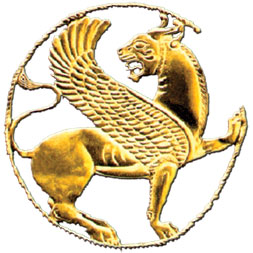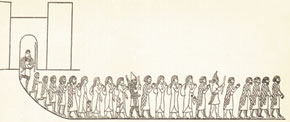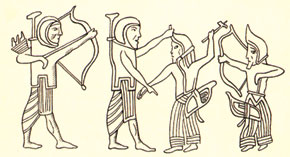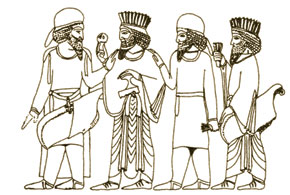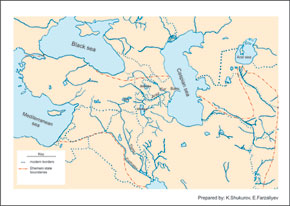Pages 58-62
by Karim K. Sukurov
Azerbaijani lands as part of the Median and Ahamani empires.
Azerbaijan in the times of Alexander the Great (early 6th century – 320s BC)
In the March-April and May-June 2010 issues of our magazine, we presented Sections I and II of a project by doctor of historical science Karim Shukurov, entitled “Azerbaijani history: from the furthest past to the present day”. We now present Section III of this project.
The arrival of Mada and Farsi tribes in Iran. The state of Media. Southern Azerbaijan as part of the state of Media. About Northern Azerbaijani lands. The state of Ahamani. Azerbaijani lands as part of the state of Ahamani. Azerbaijan in the era of Alexander the Great.
The arrival of the Mada and Farsi tribes in Iran
Mada (Median) and Farsi tribes arrived in the area that was later called Iran (the name “Iran” is said to have emerged in the 3rd century) in the late 2nd millennium BC – early 1st millennium BC. The Mada were mentioned for the first time in connection with events in the 830s BC in the Assyrian king Salmanasar III’s chronicle (860-825). The Mada were located east and south-east of Manna. They lived in small settlements and were led by the settlement heads. The Farsi were settled in Elam´s Anshan region (later called Parsumash, or Persida).
The state of Media (673-550 BC)
Assyria tried to bring the territories where the Mada were based under its sway, and succeeded in doing so. The Mada fought in vain against Assyrian rule. The situation changed, however, with the arrival of Scythians in West Asia. The Mada set up a coalition against Assyria. The rebels, led by Kashtariti from Media´s Bit-Kari province, won and the state of Media was established in 673 BC, centred on Hamadan (Ekbatana). Kashtariti (673-52) launched an extensive policy of occupation. However, the Scythians seized power in Media in 653 BC and their rule lasted for 28 years. Kashtariti’s son Kiaksar (625-585) managed to regain power in Media and a regular army was organized in order to strengthen the state.
In such circumstances, the conflict between Assyria and Babylon was exacerbated. In 616 BC Babylon defeated the Assyrians. Kiaksar also attacked Assyria and achieved a number of victories. In 612 BC, Median and Babylonian troops seized the Assyrian capital, Nineveh, and Assyria ceased to exist as a state in 605. Media was then the East’s most powerful state. Cropping, cattle breeding and craftsmanship dominated its economic life. Important trade routes ran through it to Central Asia, India and other places. Zoroastrianism was the official state religion.
Media’s rise failed to last long. The state fell under its last ruler, Astiag (585-50).
Southern Azerbaijan as part of the state of Media
As well as fighting Assyria, the Mada also subdued the Manna, Urartu and Scythian kingdoms. Apparently, they had a different status for some time – they had the right to self-governance as junior allies. However, this did not last long, either. Manna was mentioned for the last time in 593. It is believed that later Manna’s self-governance came to an end and Median rule was established there.
The lands of the former Manna, or Southern Azerbaijan, were important to life in the state of Media. Media´s social-political, economic and cultural life also influenced its development.
About the lands of Northern Azerbaijan
There is no unanimous opinion about the political situation in Azerbaijan´s northern lands during the time of the Median state (673-550 BC). Some historians believe that the lands north of the River Araz were not part of Media. In this case, one can talk about their neighbourly relations with Media. At the same time, others hold the view that some regions of Northern Azerbaijan were part of the state of Media.
The state of Ahamani(550-330 BC)
As already noted, the Farsi who arrived in Iran settled in Parsumash, or Persida. In 673 BC, the Mada established a state and brought them, too, under their sway. Gradually, the process of consolidation strengthened among the Farsi. With the deterioration in the state of Media under Astiag, the Farsi became more active; they fought a war with the Mada from 553-50 BC. In 550, Cyrus II ‘the Great’ (558-30) took Astiag captive, Media’s capital Ekbatana was destroyed, the state of Media fell and became a satrapy of the newly-established state of Ahamani (Hakhamanish). After the death of Cyrus II, Kambiz II (530-22) came to power. Under Kambiz, the domestic situation in the state deteriorated. Discontented forces took advantage of the ruler’s absence during his visit to Egypt in 526 BC and renewed their actions. The rebellion was led by a magus called Gaumata. It is believed that Gaumata wanted to restore the rule of the Mada. Darius I (522-486) suppressed Gaumata’s rebellion and others that took place later. He carried out administrative, military-political and financial and tax reforms to strengthen the state.
Darius I split the state into 20 satrapies. The policy he followed in the years that he was in power was reflected in an inscription on a stone on Mount Bisutun (between Kermanshah and Hamadan, ancient Media). Since his personal motives are declared in Darius I’s inscription, it is the main source for studying the history of that period.
The cities of Hamadan, Suz, Persepol and Babylon were state capitals.
Discontent among the peoples of the empire, on the one hand, and a Greek-Iranian war (500-449) on the other, weakened the Ahamani state. The satraps started to act independently. A campaign by Alexander the Great against the Ahamani state brought about its downfall.
Azerbaijani lands as part of the state of Ahamani
After the fall of the state of Media, the former lands of Manna that had been part of it were seized by Ahamani.
The situation in Southern Azerbaijan was different to that in the lands north of the River Araz. According to one theory in Azerbaijani historiography, there was a Massaget kingdom in the Azerbaijani lands between Derbent and Gilgilchay. In order to seize these areas, Cyrus II organized a campaign against the Massagets in 593 BC. The Massaget ruler Tomiris defeated Cyrus II and the ruler of Media was killed. Thus, Cyrus II’s attempt to capture Azerbaijani lands failed.
According to another theory, the Massagets were located in Central Asia. In this case, a Cyrus II campaign for Northern Azerbaijani lands also cannot be ruled out.
Under Darius I, the Northern Azerbaijani lands joined the state of Ahamani. Information about the satrapies also confirms that Azerbaijan joined the state of Ahamani. Azerbaijani lands were included in satrapies 10, 11 and 14.
Azerbaijani lands were important to the economic and cultural life of the state of Ahamani. The satrapies that these lands were part of paid a lot of taxes into the treasury and took part in the rulers’ military campaigns. The mutual impacts of this relationship are clear from cultural relics. Two column bases from a palace (5th-4th centuries BC), discovered in Saritapa (Qazakh District) are the same as column bases in the capital cities Suz and Persepol in the state of Ahamani.
Azerbaijan in the times of Alexander the Great
While the Ahamani state weakened, events were taking place in the Balkans, in Macedonia, that were to change its fate. The state of Macedonia appeared in the 5th century BC. It rose to prominence in the 4th century. Philip II (359-36 BC) established Macedonian rule in Greece after the battle of Chaeronea. War against the state of Ahamani appeared to be on the agenda but Philip II was killed during preparations.
Philip II’s son, the 21-year-old Alexander (336-23 BC), called Isgandar in the East, replaced him and continued his policy.
A huge range of historical, literary and art works have been written about Alexander the Great from his lifetime down to the modern period, so one might say that a special Isgandarography has developed. Among the most important are works by Diodorus (90-21 BC) and Plutarch (approx. 45-127) etc. There are anti-Isgandar works, too. At the same time, most writers have rated highly his personality, statehood and military skills.
While Macedonia’s rise continued, Ahamani fell into deeper decline. At the same time as Alexander, Kodoman, who was an offshoot of the ruling dynasty in the state of Ahamani, ascended to the throne under the name Darius III (336-30 BC).
Before the war against the Ahamani, Alexander mainly wanted to confine himself to seizing Asia Minor. However, the crisis in that state inspired him to wider conquests.
In the spring of 334 BC, he crossed the Hellespont (Dardanelles) and in May he defeated the vanguard of the Ahamani army on the bank of the River Granik. In 333 BC, the full army, led personally by Darius III, sustained a defeat near Issus and the ruler fled. In 332-31, Alexander seized Egypt. On 1 October 331, he gained a decisive victory over Darius III at the battle of Gavgamel. Darius III fled again and was killed by one of his satraps in 330. The state of Ahamani collapsed. Alexander continued his conquests and seized territories as far as west India. It was only in 326 that he returned. He died on 13 June 323 in the empire’s capital, the city of Babylon. With Alexander’s campaign in the East, the Hellenistic period began and, after his death, a number of Hellenistic states appeared within the territory of the empire.
It is difficult to paint a full picture of Azerbaijan in the Alexander’s times. However, some facts enable us to express certain opinions. Historical sources show that the Mada under the command of satrap Atropat fought at Gavgamel. In this battle, Cadusis, Albanians and Sakesins, who were from Azerbaijan, were combined with the Mada. This means that Atropat, who represented Azerbaijan, was effectively on the opposite side to Alexander. However, as events evolved, the satrap managed to approach the great leader. Atropat was initially removed from his post but a short time afterwards, in 328 BC, he was reinstated. The Greek geographer and historian Strabo (64 BC – 24 AD) wrote in his “Geography” that Media was divided into two parts. One part was called Great Media... the other part was Atropat Media: it took its name from the military leader Atropat who had not allowed his country to be subdued by the Macedonians like Great Media. This is also confirmed by the fact that Atropat’s daughter married Perdika, who assumed power after Alexander, and declared his father-in-law’s independence. At the same time, one can say that Azerbaijani lands had a significant position in the Hellenist system. It is no coincidence that Alexander’s personality and the influence of the antique period left certain traces in Azerbaijan. Alexander is one of the main characters in Azerbaijani folklore and written literature. The great Azerbaijani poet Nizami Ganjavi (1141-1209) named the last of his five poems “Isgandarnama” (in approximately 1203). The word “antiq” (precious, valuable, rarely found, very beautiful etc) in the Azerbaijani language appeared under the influence of the word “antique”.
The Alexander the Great / Isgandar of Macedon period resulted in the restoration of statehood with the establishment of the state of Atropatena in southern Azerbaijan, and the establishment of statehood - the state of Albania - in the north.
About the writer: Karim Shukurov is Doctor of Historical Science at the Institute of History of the Azerbaijani National Academy of Sciences. Member of the Expert Commission on Historical and Political Sciences of the Appraisal Commission attached to the President of the Azerbaijan Republic.
Literature
Aliyev I. Istoriya Midii. Baku, 1960
Qerodot. Istoriya. M., 1985
Dandamayev M.A. Politicheskaya Istoriya Akhmenidskoy Derjavi. M., 1985
Dyakonov I.M. Istoriya Midii. M.-L., 1956
Kurtsiy Ruf. Istoriya Aleksandra Makedonskoqo. M., 1963
by Karim K. Sukurov
Azerbaijani lands as part of the Median and Ahamani empires.
Azerbaijan in the times of Alexander the Great (early 6th century – 320s BC)
In the March-April and May-June 2010 issues of our magazine, we presented Sections I and II of a project by doctor of historical science Karim Shukurov, entitled “Azerbaijani history: from the furthest past to the present day”. We now present Section III of this project.
The arrival of Mada and Farsi tribes in Iran. The state of Media. Southern Azerbaijan as part of the state of Media. About Northern Azerbaijani lands. The state of Ahamani. Azerbaijani lands as part of the state of Ahamani. Azerbaijan in the era of Alexander the Great.
The arrival of the Mada and Farsi tribes in Iran
Mada (Median) and Farsi tribes arrived in the area that was later called Iran (the name “Iran” is said to have emerged in the 3rd century) in the late 2nd millennium BC – early 1st millennium BC. The Mada were mentioned for the first time in connection with events in the 830s BC in the Assyrian king Salmanasar III’s chronicle (860-825). The Mada were located east and south-east of Manna. They lived in small settlements and were led by the settlement heads. The Farsi were settled in Elam´s Anshan region (later called Parsumash, or Persida).
The state of Media (673-550 BC)
Assyria tried to bring the territories where the Mada were based under its sway, and succeeded in doing so. The Mada fought in vain against Assyrian rule. The situation changed, however, with the arrival of Scythians in West Asia. The Mada set up a coalition against Assyria. The rebels, led by Kashtariti from Media´s Bit-Kari province, won and the state of Media was established in 673 BC, centred on Hamadan (Ekbatana). Kashtariti (673-52) launched an extensive policy of occupation. However, the Scythians seized power in Media in 653 BC and their rule lasted for 28 years. Kashtariti’s son Kiaksar (625-585) managed to regain power in Media and a regular army was organized in order to strengthen the state.
In such circumstances, the conflict between Assyria and Babylon was exacerbated. In 616 BC Babylon defeated the Assyrians. Kiaksar also attacked Assyria and achieved a number of victories. In 612 BC, Median and Babylonian troops seized the Assyrian capital, Nineveh, and Assyria ceased to exist as a state in 605. Media was then the East’s most powerful state. Cropping, cattle breeding and craftsmanship dominated its economic life. Important trade routes ran through it to Central Asia, India and other places. Zoroastrianism was the official state religion.
Media’s rise failed to last long. The state fell under its last ruler, Astiag (585-50).
Southern Azerbaijan as part of the state of Media
As well as fighting Assyria, the Mada also subdued the Manna, Urartu and Scythian kingdoms. Apparently, they had a different status for some time – they had the right to self-governance as junior allies. However, this did not last long, either. Manna was mentioned for the last time in 593. It is believed that later Manna’s self-governance came to an end and Median rule was established there.
The lands of the former Manna, or Southern Azerbaijan, were important to life in the state of Media. Media´s social-political, economic and cultural life also influenced its development.
About the lands of Northern Azerbaijan
There is no unanimous opinion about the political situation in Azerbaijan´s northern lands during the time of the Median state (673-550 BC). Some historians believe that the lands north of the River Araz were not part of Media. In this case, one can talk about their neighbourly relations with Media. At the same time, others hold the view that some regions of Northern Azerbaijan were part of the state of Media.
The state of Ahamani(550-330 BC)
As already noted, the Farsi who arrived in Iran settled in Parsumash, or Persida. In 673 BC, the Mada established a state and brought them, too, under their sway. Gradually, the process of consolidation strengthened among the Farsi. With the deterioration in the state of Media under Astiag, the Farsi became more active; they fought a war with the Mada from 553-50 BC. In 550, Cyrus II ‘the Great’ (558-30) took Astiag captive, Media’s capital Ekbatana was destroyed, the state of Media fell and became a satrapy of the newly-established state of Ahamani (Hakhamanish). After the death of Cyrus II, Kambiz II (530-22) came to power. Under Kambiz, the domestic situation in the state deteriorated. Discontented forces took advantage of the ruler’s absence during his visit to Egypt in 526 BC and renewed their actions. The rebellion was led by a magus called Gaumata. It is believed that Gaumata wanted to restore the rule of the Mada. Darius I (522-486) suppressed Gaumata’s rebellion and others that took place later. He carried out administrative, military-political and financial and tax reforms to strengthen the state.
Darius I split the state into 20 satrapies. The policy he followed in the years that he was in power was reflected in an inscription on a stone on Mount Bisutun (between Kermanshah and Hamadan, ancient Media). Since his personal motives are declared in Darius I’s inscription, it is the main source for studying the history of that period.
The cities of Hamadan, Suz, Persepol and Babylon were state capitals.
Discontent among the peoples of the empire, on the one hand, and a Greek-Iranian war (500-449) on the other, weakened the Ahamani state. The satraps started to act independently. A campaign by Alexander the Great against the Ahamani state brought about its downfall.
Azerbaijani lands as part of the state of Ahamani
After the fall of the state of Media, the former lands of Manna that had been part of it were seized by Ahamani.
The situation in Southern Azerbaijan was different to that in the lands north of the River Araz. According to one theory in Azerbaijani historiography, there was a Massaget kingdom in the Azerbaijani lands between Derbent and Gilgilchay. In order to seize these areas, Cyrus II organized a campaign against the Massagets in 593 BC. The Massaget ruler Tomiris defeated Cyrus II and the ruler of Media was killed. Thus, Cyrus II’s attempt to capture Azerbaijani lands failed.
According to another theory, the Massagets were located in Central Asia. In this case, a Cyrus II campaign for Northern Azerbaijani lands also cannot be ruled out.
Under Darius I, the Northern Azerbaijani lands joined the state of Ahamani. Information about the satrapies also confirms that Azerbaijan joined the state of Ahamani. Azerbaijani lands were included in satrapies 10, 11 and 14.
Azerbaijani lands were important to the economic and cultural life of the state of Ahamani. The satrapies that these lands were part of paid a lot of taxes into the treasury and took part in the rulers’ military campaigns. The mutual impacts of this relationship are clear from cultural relics. Two column bases from a palace (5th-4th centuries BC), discovered in Saritapa (Qazakh District) are the same as column bases in the capital cities Suz and Persepol in the state of Ahamani.
Azerbaijan in the times of Alexander the Great
While the Ahamani state weakened, events were taking place in the Balkans, in Macedonia, that were to change its fate. The state of Macedonia appeared in the 5th century BC. It rose to prominence in the 4th century. Philip II (359-36 BC) established Macedonian rule in Greece after the battle of Chaeronea. War against the state of Ahamani appeared to be on the agenda but Philip II was killed during preparations.
Philip II’s son, the 21-year-old Alexander (336-23 BC), called Isgandar in the East, replaced him and continued his policy.
A huge range of historical, literary and art works have been written about Alexander the Great from his lifetime down to the modern period, so one might say that a special Isgandarography has developed. Among the most important are works by Diodorus (90-21 BC) and Plutarch (approx. 45-127) etc. There are anti-Isgandar works, too. At the same time, most writers have rated highly his personality, statehood and military skills.
While Macedonia’s rise continued, Ahamani fell into deeper decline. At the same time as Alexander, Kodoman, who was an offshoot of the ruling dynasty in the state of Ahamani, ascended to the throne under the name Darius III (336-30 BC).
Before the war against the Ahamani, Alexander mainly wanted to confine himself to seizing Asia Minor. However, the crisis in that state inspired him to wider conquests.
In the spring of 334 BC, he crossed the Hellespont (Dardanelles) and in May he defeated the vanguard of the Ahamani army on the bank of the River Granik. In 333 BC, the full army, led personally by Darius III, sustained a defeat near Issus and the ruler fled. In 332-31, Alexander seized Egypt. On 1 October 331, he gained a decisive victory over Darius III at the battle of Gavgamel. Darius III fled again and was killed by one of his satraps in 330. The state of Ahamani collapsed. Alexander continued his conquests and seized territories as far as west India. It was only in 326 that he returned. He died on 13 June 323 in the empire’s capital, the city of Babylon. With Alexander’s campaign in the East, the Hellenistic period began and, after his death, a number of Hellenistic states appeared within the territory of the empire.
It is difficult to paint a full picture of Azerbaijan in the Alexander’s times. However, some facts enable us to express certain opinions. Historical sources show that the Mada under the command of satrap Atropat fought at Gavgamel. In this battle, Cadusis, Albanians and Sakesins, who were from Azerbaijan, were combined with the Mada. This means that Atropat, who represented Azerbaijan, was effectively on the opposite side to Alexander. However, as events evolved, the satrap managed to approach the great leader. Atropat was initially removed from his post but a short time afterwards, in 328 BC, he was reinstated. The Greek geographer and historian Strabo (64 BC – 24 AD) wrote in his “Geography” that Media was divided into two parts. One part was called Great Media... the other part was Atropat Media: it took its name from the military leader Atropat who had not allowed his country to be subdued by the Macedonians like Great Media. This is also confirmed by the fact that Atropat’s daughter married Perdika, who assumed power after Alexander, and declared his father-in-law’s independence. At the same time, one can say that Azerbaijani lands had a significant position in the Hellenist system. It is no coincidence that Alexander’s personality and the influence of the antique period left certain traces in Azerbaijan. Alexander is one of the main characters in Azerbaijani folklore and written literature. The great Azerbaijani poet Nizami Ganjavi (1141-1209) named the last of his five poems “Isgandarnama” (in approximately 1203). The word “antiq” (precious, valuable, rarely found, very beautiful etc) in the Azerbaijani language appeared under the influence of the word “antique”.
The Alexander the Great / Isgandar of Macedon period resulted in the restoration of statehood with the establishment of the state of Atropatena in southern Azerbaijan, and the establishment of statehood - the state of Albania - in the north.
About the writer: Karim Shukurov is Doctor of Historical Science at the Institute of History of the Azerbaijani National Academy of Sciences. Member of the Expert Commission on Historical and Political Sciences of the Appraisal Commission attached to the President of the Azerbaijan Republic.
Literature
Aliyev I. Istoriya Midii. Baku, 1960
Qerodot. Istoriya. M., 1985
Dandamayev M.A. Politicheskaya Istoriya Akhmenidskoy Derjavi. M., 1985
Dyakonov I.M. Istoriya Midii. M.-L., 1956
Kurtsiy Ruf. Istoriya Aleksandra Makedonskoqo. M., 1963
